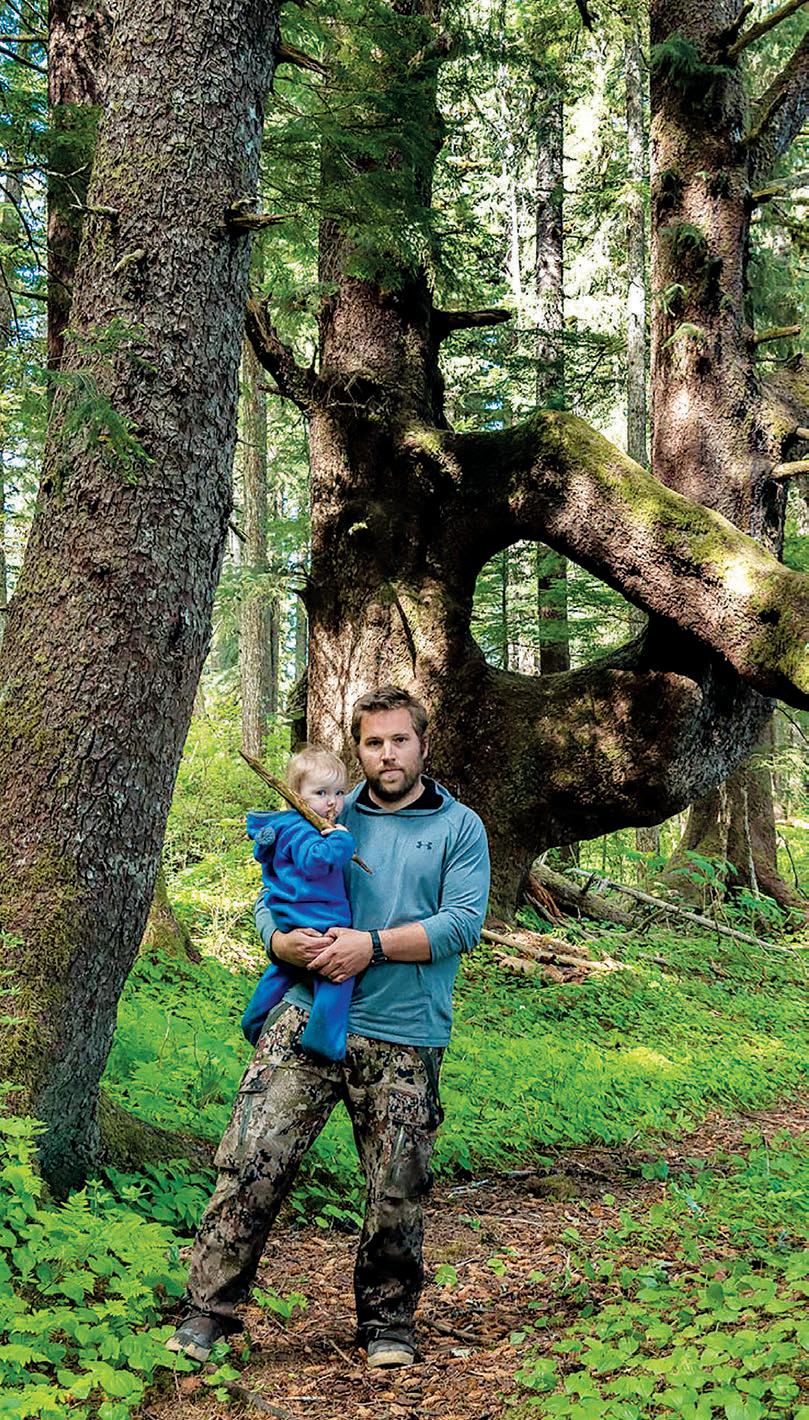
7 minute read
THE LEGEND OF GRIZZLY ADAMS
Black bears are now omnipresent in California, but it’s the grizzly that adorns the state flag. While the latter species is considered extinct inside the state’s borders, as author Bjorn Dihle explains in his new book, one man became famous for his interactions with grizzlies when he came to the Golden State.
ADAMS AND HIS GRIZZLY FAMILY
BOOK EXCERPT: AN ADVENTURER’S CALIFORNIA EXPERIENCE WITH GRIZZLIES
The 1848 discovery of gold in Northern California’s Sutter’s Mill inspired a ragtag bunch of characters, eccentrics, kooks, dreamers and adventure seekers who flocked to the area around Sacramento looking to strike it rich. When James Carpen Adams headed west – bankrupt, broken and battered – his rush proved to come more from up-close-and-personal connections with bears than buckets of nuggets.
The man who would forever be known as Grizzly Adams – idolized in memoirs and via a memorable TV title character – found his place in Golden State lore for his experiences with the state’s now iconic and extinct grizzlies, one of which adorns the state’s flag. Adams’ story caught the eye of Alaska-based writer and outdoorsman Bjorn Dihle, who has his own fascination with bruins and compiled many personal and historical stories into a new book, A Shape in the Dark: Living and Dying with Brown Bears.
“I’ve always been drawn to wild country, and no animal better embodies the spirit of the wild than the brown bear,” Dihle says. “I’ve been lucky to get to spend a lot of time in close proximity with them – much of the spring and summer I work guiding wildlife film crews… This book is a project that gestated for 10 years. Probably even longer.”
The following is excerpted with permission from A Shape in the Dark: Living and Dying with Brown Bears by Bjorn Dihle (Mountaineers Books, 2021).

By Bjorn Dihle
In 1848, at the end of the MexicanAmerican War, the United States claimed California. Gold was found in the Sierra, and a stampede of more than 300,000 prospectors journeyed to California by land and water.
One of these men was a 37-yearold Massachusetts shoemaker named James Capen Adams. He invested all his savings – and likely his father’s too – in footwear to sell to prospectors, then left his wife and children to follow the stampede west. A cholera epidemic was ravaging St. Louis when he arrived.

While he was arranging to transport his merchandise to California, a steamboat caught flame, and the city burned. All of Adams’s investment was lost. Soon after, he received word his father had killed himself. The cobbler wandered the charred ruins of St. Louis as wagons passed by carrying corpses – more than 5,000 died of cholera that summer.
He was faced with a tough decision: go home ruined or go west to seek fortune. He packed what few belongings he had and began following the Santa Fe Trail west. He suffered hunger and cold, nearly dying twice from disease before arriving in Los Angeles sometime in the fall.
AMERICAN SETTLERS HAD COME to California in droves and, being well armed and possessing zero tolerance for anything that contested their dominion over the land, set about systematically killing grizzlies.
Adams made and lost fortunes prospecting, ranching and leatherworking, “until at last,” he wrote in his autobiography, “in the fall of 1852, disgusted with the world and dissatisfied with myself, I abandoned all my schemes for the
James Capen Adams (circa 1860) was a penniless shoemaker who fled to California in search of a better life. He’d soon become obsessed with the bears he encountered in the state and would forever be known to historians and in pop culture as “Grizzly



Author Bjorn Dihle and his son Shiras walk a bear trail on Admiralty Island in Alaska, where he’s encountered many bears on his outdoor adventures. “When I vacation, I generally go wander in brown bear country,” he says. (CHRIS MILLER)
accumulation of wealth, turned my back upon the society of my fellows, and took the road toward the wildest and most unfrequented parts of the Sierra Nevada, resolved thenceforth to make the wilderness my home and wild beasts my companions.”
Adams wasn’t always a cobbler. He’d once worked as a hunter, trapper and trainer of wild animals. His career ended when he made a near-fatal mistake by turning his back on a Bengal tiger he’d been training, leaving him scarred and with a permanent limp.
In the Sierra, he reverted to skills he’d developed in his youth and set off on expeditions deep into the wilderness, sometimes going as far as what is today Washington state and the western edge of the Rocky Mountains. He hunted, trapped, and developed a deep affinity for grizzly bears. It’s unlikely that anyone in history has been mauled by bears more times than Adams – one encounter left him with a crushed skull and part of his brain exposed.
After a short convalescence, he went back to the business of killing and capturing bears and whatever else walked on four legs.

THERE ARE OTHER, MOSTLY forgotten, bear men who fill the history of the West. Two things set Adams apart from his peers. First, Adams would capture cubs after he killed their mothers, and with a firm hand and deep knowledge of animal psychology, he turned several of these orphans into servants and even friends.
He’d use the bears as pack animals to carry hides of other animals, often grizzlies. He’d hunt with them – at one point a bear he named Benjamin Franklin saved him by fighting off a mother grizzly he had wounded. After a few years of roaming, as civilization turned places like San Francisco from camps into bustling cities, he took on the moniker Grizzly Adams and cashed in on the menagerie business with his captive grizzlies as the star attractions.
Second, in 1859 Theodore H. Hittell, a San Francisco journalist fascinated
by Adams, spent an extensive amount of time interviewing the mountain/ circus man and writing a book about his adventures. That same year, Adams – sensing he was dying and perhaps missing his family – loaded a ship full of his grizzlies and other beasts and, like a modern Noah, set sail for the East Coast.
When he arrived in New York City, he was greeted by thousands of curious spectators. He rode a brown bear through the streets. Following behind him, horses pulled wagons of dozens of caged grizzlies and other wild animals from the West. He dismounted in front of a giant canvas tent that P. T. Barnum, “the greatest showman that ever lived,” had set up in advance. For the price of an admission ticket, any New Yorker

Dihle, who was stared down by a curious brown bear sow and her cub in Alaska’s Brooks Range, has plenty of stories of close encounters with one of the biggest and baddest predators of the animal kingdom. (BJORN DIHLE)
Dihle gets a close look at an Admiralty Island bear from the water. “I’ve always been drawn to wild country, and no animal better embodies the spirit of the wild than the brown bear,” he says. (CHRIS MILLER)



Of Adams, whose 1860 death is said to have been an after-effect of a previous bear attack injury, Dihle writes, “It’s unlikely that anyone in history has been mauled by bears more times than Adams. … Night after night, the dying man pantomimed adventures of the Wild West and pretended to fight grizzly bears.” (BJORN DIHLE)
could look into the eyes of a brown bear, hear stories of the West and watch Adams wrestle his bears.
For the short remainder of his life, Adams toured New York and New England as part of Barnum’s circus. Legend has it that his already ill health went into full decline after a monkey he was training bit the exposed tissue of his brain. A serious infection spread, but Adams refused to retire. He was bent on getting the full salary and bonus that Barnum had promised him if he finished his contract.
So, night after night, the dying man pantomimed adventures of the Wild West and pretended to fight grizzly bears. He fulfilled his contract, gave his wife his money and five days later at his home in Massachusetts, died in a bed he hadn’t slept in for 12 years. CS
Editor’s note: Order a copy of Dihle’s book at mountaineers.org/books/books/ashape-in-the-dark-living-and-dyingwith-brown-bears.











